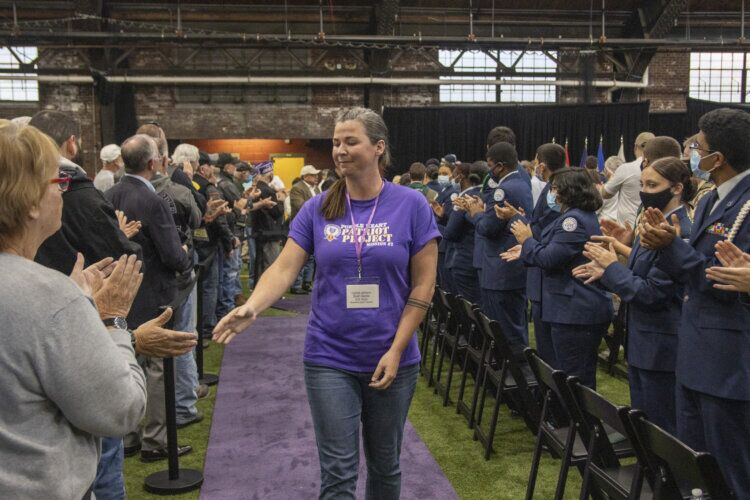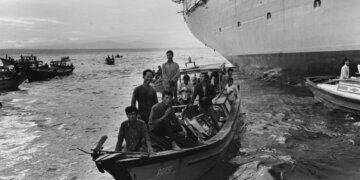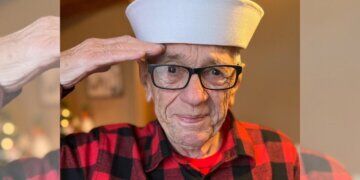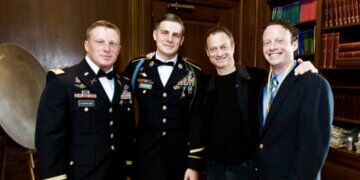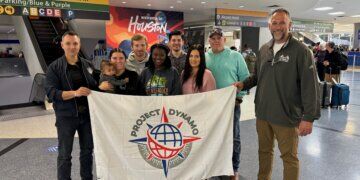On the evening of Jan. 16, 2004, Pfc. Connie Johnson — then Neill — and her company were en route to the U.S. Air Force base in Mosul. A quiet, chilly night, Johnson was wearing a neck gaiter to keep warm as she scanned the horizon from the gunner position atop her Humvee, the last in a three-truck convoy.
As they came upon the Tigris River, the vehicle bouncing up as it made contact with the foot of the bridge, Johnson quickly shifted her gaze from left to right.
“I remember a bright light, then I kind of kicked my head back and heard a massive explosion,” said Johnson, who was 20 at the time. “When the shrapnel hit me, it sliced through my neck, severing some nerves so that that whole side of my face went numb.”
Dazed, Johnson fell down into the vehicle, pulling off her neck gaiter to reveal a 2-inch deep and 6-inch long neck wound. Her team rushed her back to the air base, where she was given morphine and 10 stitches — four inside and six outside.
“I remember laying there thinking I was dying,” she said.
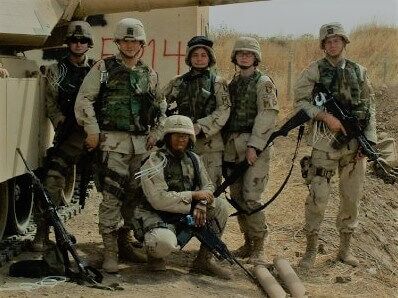
Within three to four days, Johnson had left the base, and within 10, her stitches were out and she was back on the truck going out on another mission.
“The thing that saved my life is that I had looked the other way,” she said.
Johnson’s story is one in some 1.8 million, of Americans who, as retired Col. Russell Vernon said, “left some or all of themselves on the battlefield.” Vernon is executive director of the National Purple Heart Honor Mission, an organization dedicated to ensuring that Purple Heart recipients like Johnson — those who have been wounded or killed while serving in the armed forces — are never forgotten.
The NPHHM was founded in 1997 as part of an effort spearheaded by Lt. Col. William J. Larkin Jr., a retired Army officer, World War II and Korean War veteran and New York State Senator. Larkin and three others lobbied and raised funds to build what is now the National Purple Heart Hall of Honor, a museum to honor Purple Heart recipients.
“They felt very strongly that the land in New Windsor, New York, where Gen. George Washington first awarded the Badge of Military Merit, [the precursor to the Purple Heart], should be a museum,” Vernon said.
With its original mission – to build the museum – accomplished, the NPHHM shifted its focus to pay tribute to the nation’s combat wounded through outreach and educational programs. One of its largest initiatives each year, the Purple Heart Patriot Project selects Purple Heart recipients from each state to go on an all-expenses paid trip to the National Purple Heart Hall of Honor and other historic sites connected with the medal.
The trip provides an opportunity for these veterans to connect with one another and to truly understand the significance of their sacrifice.
Johnson, South Dakota’s honoree during the 2021 Patriot Project mission, is also the only female Purple Heart recipient registered in the state.
“I’m part of that population of people, which is very small, who have been able to receive [the medal] themselves versus it being handed to a family member,” Johnson said. “Proud is a difficult word because nobody wants the medal. I’m just grateful I was alive to receive it, and I’m glad it’s something my children can learn about because their mom has one.”
The NPHHM also is engaged in an effort to create a video archive of Purple Heart recipients sharing their stories and a traveling tribute and education center. Once completed, this traveling museum will tour the nation, telling the story of the Purple Heart and its recipients, as well as collecting more stories.
“It’s critical that our young men and women understand the sacrifices [made] to have the freedoms we enjoy today,” Vernon said. “So, we’re going to be able to take a 63-foot tractor trailer across the nation, stopping at schools and sporting events, and let people walk through and see these stories.”
Purple Heart Day, held every year on Aug. 7, provides another opportunity for the NPHHM to raise awareness of the fact that “freedom isn’t free,” Vernon said.
RELATED: Iraq War: A conflict that defined the National Guard
“That is demonstrated by all the living Purple Heart recipients who bear the scars of war,” he said. “As we go about our daily lives, as ordinary Americans, we don’t see that — we don’t think about it. Purple Heart Day highlights that and gives us all a chance to personally reflect.”
Johnson believes this lack of awareness has to do with perceptions of veterans that are dated.
“When I think about veterans, I still see the Vietnam veteran in the VFW talking about his war experiences, drinking beer,” she said. “But I’m almost 40, I have three kids, and standing next to me in a line you would never know that I saw combat the way that I did, that I was injured the way that I was and that I struggled the way that I struggled. [Purple Heart Day] is an opportunity to bring awareness [to the fact] that these people are around us every day.”
While the physical effects of Johnson’s own combat experience might be more visible — like the jagged scar down the left side of her neck — the mental ones have been the most difficult to overcome, like the doubt and shame she’s continued to carry with her, having been the only one in her unit who was injured. Yet, Johnson takes comfort in the hope that by sharing her story, she’ll bring awareness and visibility to other veterans and Purple Heart recipients.
“Even though I have my own doubts and my own demons regarding what happened,” she said, “and I am still battling some of those residual [effects of] PTSD, if somebody reads my story and can relate to it in a positive way – it makes them feel better, like they’re not alone – then it is 100% worth it.”




